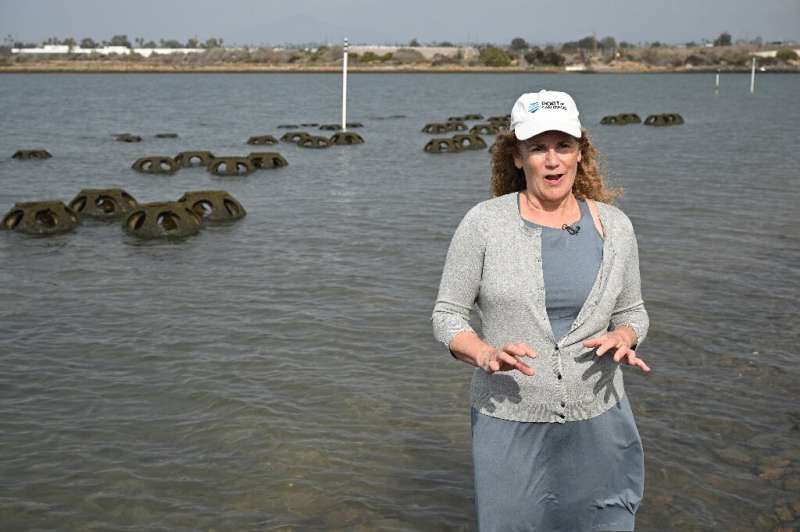Scientists hope that such reef balls in the waters off Chula Vista, Calif., will eventually help protect coastlines from erosion exacerbated by climate change.
Pearls don’t grow on oyster reefs in San Diego Bay, but scientists hope they will bring an even more valuable treasure: protection against coastal erosion caused by rising sea levels.
Thousands of tiny molluscs began to grow on artificial reefs dumped into the bay as part of a remediation plan in far southern California.
“We are looking at different ways of fighting sea level riseand these reef balls are one tool in our toolbox to do that,” Eileen Maher, director of environmental protection at the Port of San Diego, told AFP.
The port installed 360 structures last December along a peninsula wedged between Southern California’s salt marshes and the Coronado Peninsula, home to the Naval Air Station that inspired “Top Gun.”
These hemispheres weigh 300 pounds (135 kilograms) and look like huge thimbles.
They are made from a mixture of cement, sand and crushed material oyster shellsis the most important ingredient that attracts live oysters to make their home there.
After 10 months in the water, the reefs become covered in a greenish silt that hides thousands of still-microscopic oysters, Maher says.
Ultimately, the dozen or so scientists working on this pilot project hope to see it become a real oyster reefsthat they believe will have a real impact on them local environment.

Eileen Maher, director of environmental protection at the Port of San Diego, California, calls the oyster “one of the tools in our toolbox” to combat sea level rise.
Miniature filters
Reefs are much more than a natural bastion against tidal erosion; their bivalve inhabitants are miniature filter plants essential to the marine ecosystem.
This is because for the capture of nutrients an oyster To survive, each filters about 50 gallons (190 liters) of water each day, Maher said.
“They help remove that turbidity from the water and help purify the water, which will have additional benefits for the green, submerged aquatic vegetation,” she said.
“The more eels that sit in the bay, the less likely it is to erode the shoreline because it helps — any plant will help prevent shoreline erosion.”
And like oysters, these long strands of sea grass will also be an important food source for the 80 species of fish and 300 species of birds that live in the area.

The reef balls seen here form a living shoreline project for native South Bay oysters near Chula Vista, California.
Floods and erosion
Sea levels around California are expected to rise by 20 centimeters (eight inches) by 2050, according to a National Oceanic and Atmospheric Administration (NOAA) study released earlier this year.
This will lead to a dramatic increase in the frequency of flooding on the West Coast, which will also occur more often due to storms and heavy rainfall that are exacerbated by human-induced climate change.
And rising sea levels will worsen the erosion that threatens California’s coastline.
Around San Diego, that future is already evident.
In the south, the streets of Imperial Beach regularly flood during high tides. An hour’s drive north, the Pacific Surfliner rail line has just been shut down in San Clemente, where the cliffs that support it are sinking due to erosion.
In that context, “We have to make sure we’re sustainable,” said Jason Giffen, vice president of planning and environment for the Port of San Diego.

Oyster shells like the one seen at the Chula Vista Wildlife Sanctuary in California are crushed to form reef balls that attract live oysters.
A $1.3 million oyster reef The project is evaluated for five years. Similar schemes were created in San Francisco and New York.
Oyster barriers only work in shallow water, Giffen said.
Elsewhere, the port is looking for other solutions.
In the northern part of the bay, small hollow fortifications are attached to the piers.
Not only do they provide stability, but they also provide shelter for algae, fish and shellfish, helping to strengthen biodiversity.
Currently, about 70 percent of the shoreline around San Diego Bay has some type of man-made reef.
“We can look at replacing that infrastructure in the long term with something that is more biologically and ecologically sensitive and actually adds value in terms of environmental quality,” Giffen said.
© 2022 AFP
Citation: Scientists turn to humble oyster to save California coasts (2022, October 10) Retrieved October 10, 2022, from https://phys.org/news/2022-10-california-coasts-scientists-humble-oyster. html
This document is subject to copyright. Except in good faith for the purpose of private study or research, no part may be reproduced without written permission. The content is provided for informational purposes only.






